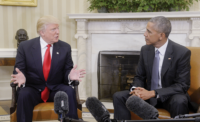Some observers expect Obama and congressional leaders to work out a short-term solution in the lame-duck session and, later on, try to achieve a longer-term fiscal package.
Stephen Sandherr, CEO of the Associated General Contractors of America, says, “I think they’re likely to give themselves some breathing space.” If so, that could involve temporarily continuing at least some of the tax cuts as well as delaying implementation of the sequestration.
After the 113th Congress convenes and Obama begins his second term, industry officials will be watching some critical legislative issues.
Infrastructure spending is among the most important issues, and Obama repeatedly has said he wants to see more “nation-building” in the U.S.
Industry would like to see Congress pass a new Water Resources Development Act (WRDA) to authorize new Army Corps of Engineers' locks and dams, dredging and environmental restoration projects. The last WRDA became law in 2007, and infrastructure needs have continued to rise since then.
Senate Environment and Public Works Committee leaders have been hammering out a draft bill, but it has yet to be unveiled. The administration has not released a proposal.
Many in construction will be focused on highway funding. Industry officials already are seeking ways to bolster the shaky Highway Trust Fund, whose highway account is projected to slip into a deficit after MAP-21 expires on Sept. 30, 2014.
Sandherr says, “We’ve got to solve the solvency problem in the Highway Trust Fund.”
If Congress takes up a long-term tax reform and deficit-reduction package in the new year, Bauer says, “It’s no secret that [package] is a viable opportunity to try to advance a long-term solution to the Highway Trust Fund’s challenges.”
Fiscal 2013 appropriations are another question mark. Congress approved a stopgap continuing resolution (CR) that funds only construction and other programs through next March 27.
Bauer says the CR didn’t fully fund transportation programs at MAP-21’s specified levels and adds that ARTBA will try to make sure Congress adds back those funds when it approves appropriations for the period beginning in April.
Organized Labor's Priorities
Organized labor gave a strong push to Obama’s campaign, both at the polls and in union members’ get-out-the-vote efforts, helping him to win battleground states such as Ohio, Wisconsin and Nevada. AFL-CIO President Richard Trumka said in a Nov. 7 press conference, “We did deliver those states.”
Trumka said labor would like to see action on a list of priority issues. For example, he said, “We want renewed investment in manufacturing, education and our basic infrastructure to create jobs here at home and increase our competitiveness.”
He noted, “We have a $2.2-trillion deficit for old infrastructure and a $2-trillion deficit to bring us into the 21st century so that we can compete with people around the world.”
Sandherr suggests that one initial signal of how labor will fare in a second Obama term is whether the administration decides to grant a permit to build the Keystone XL crude-oil pipeline from Alberta, Canada, to Oklahoma. The project has strong support from building trades unions.




.jpg?height=200&t=1638555484&width=200)

Post a comment to this article
Report Abusive Comment